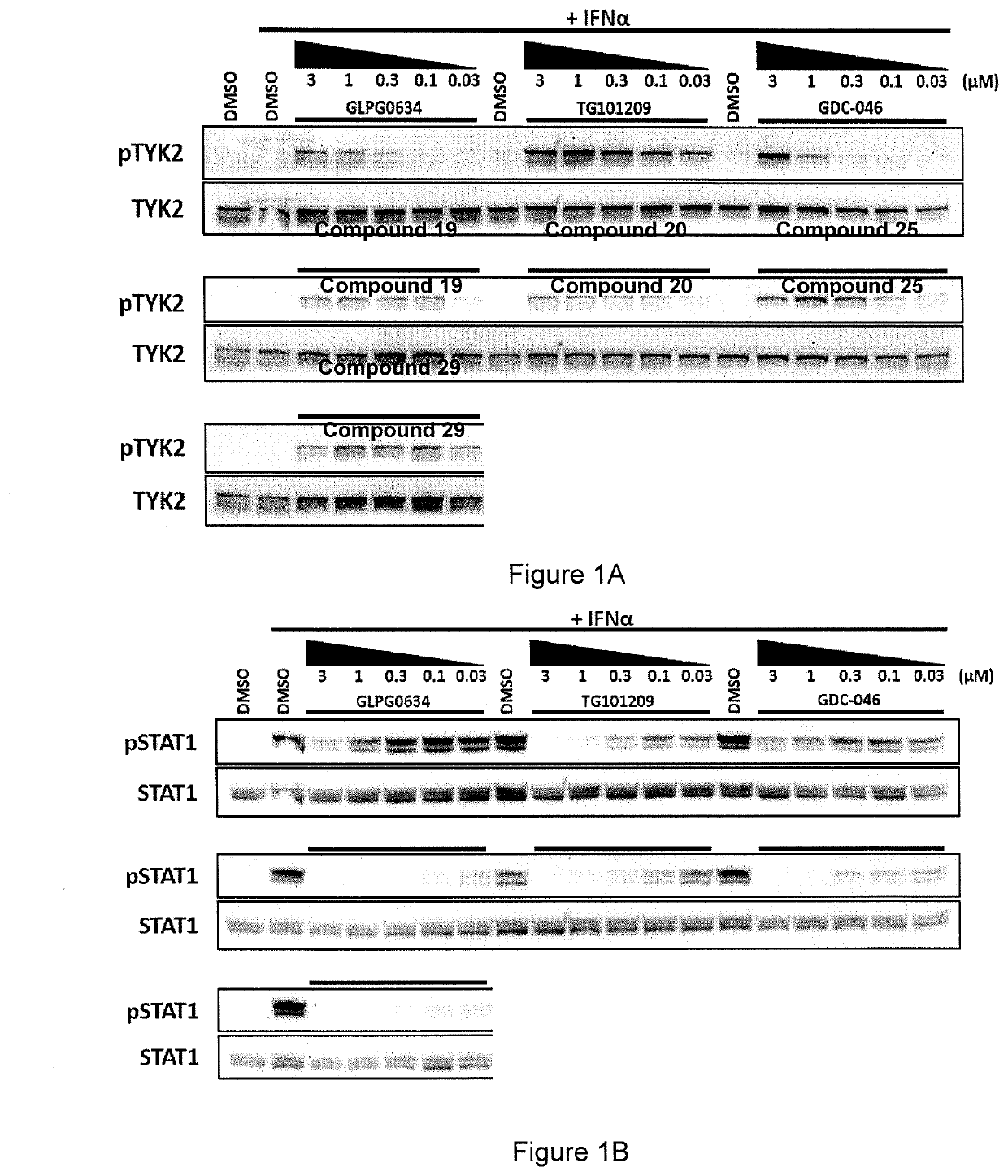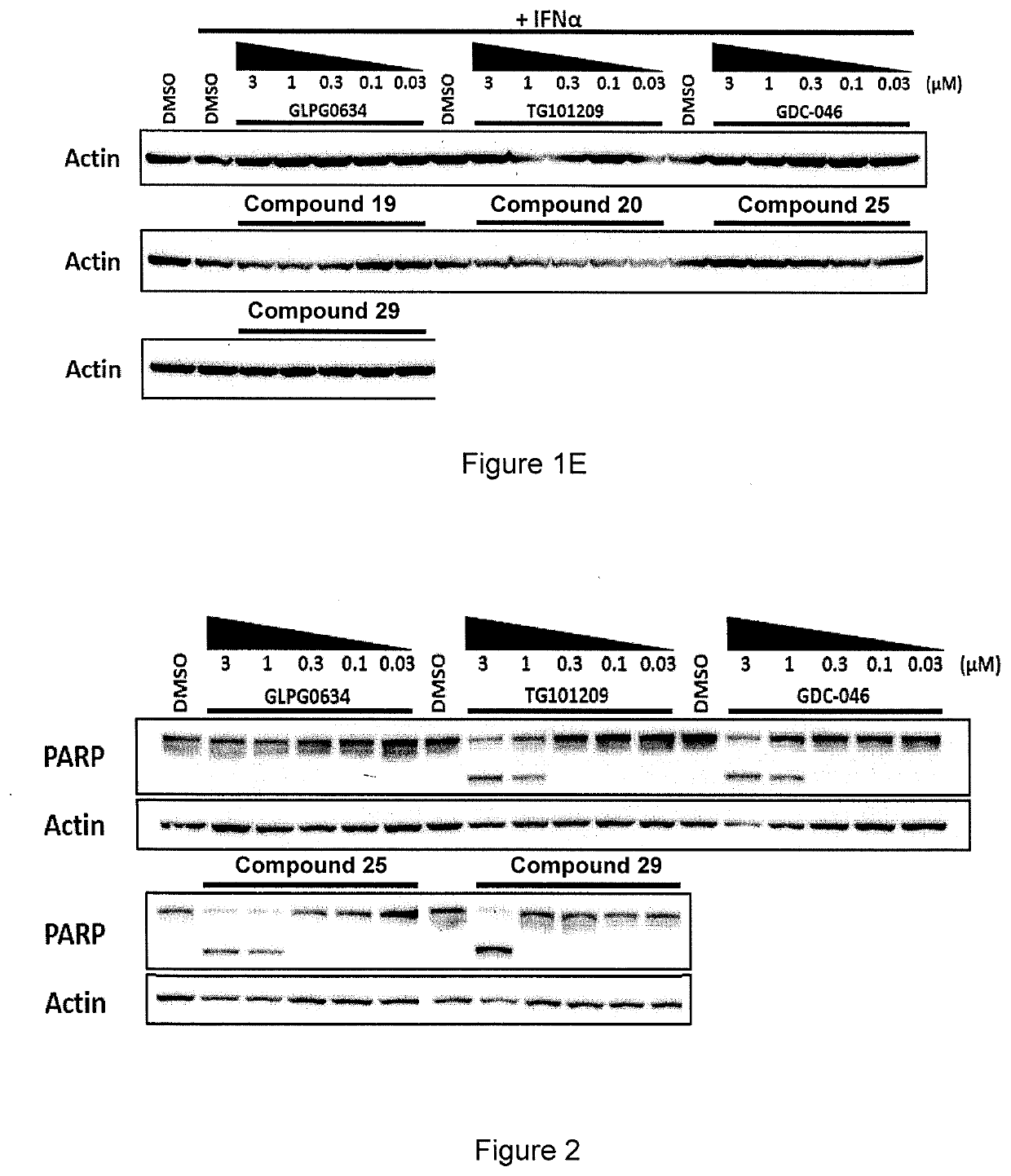Pharmaceutical compounds
a technology of pharmaceutical compounds and active ingredients, applied in the field of pharmaceutical compounds, can solve the problems of high risk of sct, inconvenient use, and serious infections, and achieve the effects of not being able to benefit every patient, and being highly risky
- Summary
- Abstract
- Description
- Claims
- Application Information
AI Technical Summary
Benefits of technology
Problems solved by technology
Method used
Image
Examples
example 1
Enzyme Inhibition
[0205]Compounds of the invention were assayed for their ability to inhibit TYK2 kinase and other JAK kinases.
[0206]Substrates and kinases used in the assays are identified in Table 2 below.
[0207]Kinase assays were performed at Reaction Biology Corp., Malvern, Pa., USA, using the following general procedure:[0208]1) Prepare indicated substrate in freshly prepared Base Reaction Buffer (20 mM Hepes pH 7.5, 10 mM MgCl2, 1 mM EGTA, 0.02% Brij35, 0.02 mg / ml BSA, 0.1 mM Na3VO4, 2 mM DTT, 1% DMSO).[0209]2) Deliver cofactors (1.5 mM CaCl2, 16 ug / mL Calmodulin, 2 mM MnCl2) to the substrate solution above[0210]3) Deliver indicated kinase into the substrate solution and gently mix[0211]4) Deliver varying concentrations of test compound in DMSO into the kinase reaction mixture[0212]5) Deliver 33P-ATP (specific activity 0.01 μCi / μL final) into the reaction mixture to initiate the reaction[0213]6) Incubate kinase reaction for 120 min at room temperature[0214]7) Reactions are spott...
example 2
Cell Proliferation Assay
[0221]Compounds 19, 20, 25 and 29 were investigated in a panel of five cell lines:[0222]Jurkat[0223]MOLT-4[0224]CCRF-CEM[0225]Loucy[0226]CCRF-HSB-2
[0227]Jurkat, MOLT-4, CCRF-CEM and CCRF-HSB-2 cells are all TYK2-dependent T-ALL cells.
[0228]Loucy cells are TYK2-independent T-ALL cell lines.
[0229]Dexamethasone, Etoposide and Paclitaxel were used as positive controls.
[0230]Compound effects were studied 7 days after compound addition
Protocol
[0231]Cells were seeded in 384-well plates at the appropriate density and allowed to adhere overnight prior to addition of compound or vehicle control.[0232]Compounds 19, 20, 25 and 29 were prepared from DMSO stocks to give a final concentration range of between approximately 3 nM and 30 μM. The final DMSO concentration was constant at 0.15%.[0233]Test compounds were incubated with the cells for 7 days at 37° C. 5% CO2 in a humidified atmosphere.[0234]A volume of ATPlite reagent, equal to the volume of cell culture medium pres...
example 3
Western Blot Assay—Short Term Compound Treatment
[0237]Jurkat cells were treated with Compounds 19, 20, 25 and 29 (of Example 1) and three benchmark inhibitors (GLPG0634 (Filgotinib, developed by Galapagos), TG101209 and GDC-046) as comparative examples using the protocol set out below.
[0238]Cells were incubated with compounds at five concentrations (3, 1, 0.3, 0.1 & 0.03 μM) for 1 hr, then stimulated with INFα for 20 m, before cells were harvested.
[0239]Cell lysates were analysed by Western blot and then probed with antibodies against the following:[0240]phospho-TYK2 / total-TYK2[0241]phospho-STAT1 / total-STAT1[0242]phospho-STAT3 / total-STAT3[0243]phospho-STAT5 / total-STAT5[0244]Actin
[0245]The details of the antibodies are set out in the table below.
SizeIncubation / Antigen(kDa)SupplierCat. No.DilutionBlock ConditionsSecondaryTYK2134Cell93121:500 o / n 4° C. 5%Anti-RabbitSignallingBSApTYK2134Cell93211:500 o / n 4° C. 5%Anti-Rabbit(Tyr1054 / 1055)SignallingBSAJAK1130Cell33441:5000o / n 4° C. 5%Anti...
PUM
| Property | Measurement | Unit |
|---|---|---|
| Fraction | aaaaa | aaaaa |
| Temperature | aaaaa | aaaaa |
| Molar density | aaaaa | aaaaa |
Abstract
- hydrogen;
- an optionally substituted C1-6 non-aromatic hydrocarbon group; and
- optionally substituted 3- to 7-membered non-aromatic carbocyclic and heterocyclic rings containing one or two heteroatom ring members selected from O, N and S, and bridged bicyclic heterocyclic rings of seven to nine ring members of which one or two are nitrogen atoms, the carbocyclic and heterocyclic rings and bridged bicyclic heterocyclic rings;
Description
Claims
Application Information
 Login to View More
Login to View More - R&D
- Intellectual Property
- Life Sciences
- Materials
- Tech Scout
- Unparalleled Data Quality
- Higher Quality Content
- 60% Fewer Hallucinations
Browse by: Latest US Patents, China's latest patents, Technical Efficacy Thesaurus, Application Domain, Technology Topic, Popular Technical Reports.
© 2025 PatSnap. All rights reserved.Legal|Privacy policy|Modern Slavery Act Transparency Statement|Sitemap|About US| Contact US: help@patsnap.com



